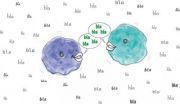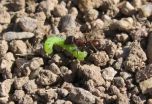(Press-News.org) Satellite measurement of sea surface temperatures has yielded clear evidence of major changes taking place in the waters of Australia's Great Barrier Reef over the past 25 years, marine scientists have found.
The changes have big implications for the future management of the GBR and its marine protected areas say Dr Natalie Ban and Professor Bob Pressey of the ARC Centre of Excellence for Coral Reef Studies and James Cook University, who led the study with Dr Scarla Weeks from the University of Queensland.
"When we looked back at satellite data collected since 1985, we found evidence that most of the regions of the GBR are changing significantly, in terms of sea surface temperature – especially in the southern part of the reef," Dr Ban, who is the lead author of a new scientific paper on the issue, says.
"Risk of coral bleaching increases with higher water temperatures. Across the whole reef we found water temperatures increasing by an average of 0.2 of a degree over a quarter of a century – but the increase was significantly more in some areas.
"For example, off Rockhampton the water has warmed by about half a degree over the last 25 years."
The changes were also altering the seasonal patterns of water temperature at particular places along the reef, Dr Ban says. "In some areas summer is coming earlier and lasting longer; in others, both summers and winters are warmer than in the past. This all affects the sea life."
The research has revealed temperature conditions are dynamic, with warmer waters moving in both space and time – posing new questions for the management of Green Zones and other protected areas which tend to be fixed.
"Some people think we ought to have the highest levels of protection for areas that are changing the least, so they remain as refugia to recharge the surrounding reef areas," Dr Ban says.
"Others argue the opposite – that the greatest protection should be afforded to the most vulnerable areas.
"Others still argue that Green Zones and other types of restrictions should migrate geographically along with the climate – that their boundaries should change gradually in line with trends in water temperature and reef biology.
"Our aim in publishing this paper on what is actually happening is to stimulate and inform this discussion, so that we can come up with the best and most flexible system for managing the GBR through what will undoubtedly be momentous environmental change."
The present Green Zones, where fishing is prohibited, cover the same temperature ranges as the whole reef, she says – but the debate on what to do next is only now getting under way.
With a view to encouraging discussion, the team has put forward three alternative scenarios for how the temperature data can be used to design appropriate management strategies for protected areas.
"We need to understand what we are managing for, to have the best management plan," she explains.
Australia is recognised as a world leader in managing coral reefs, and was again leading global thinking about how to best manage them as waters warm and conditions change. "We hope that our research will also prove valuable to countries of the Coral Triangle who are trying to manage the world's centre of coral diversity through this challenging period," she says
###Their paper "Conservation Objectives and Sea-Surface Temperature Anomalies in the Great Barrier Reef" by Natalie C.Ban, Robert L Pressey and Scarla Weeks, appears online in the journal Conservation Biology at http://onlinelibrary.wiley.com/doi/10.1111/j.1523-1739.2012.01894.x/full.
More information:
Dr Natalie Ban, CoECRS and JCU, ph +61 (0) 420 328 858 or +61 (0)7 4781 6067
Professor Bob Pressey, CoECRS and JCU, ph +61 (0) 418 387 681
Jenny Lappin, CoECRS, +61 417 741 638
Jim O'Brien, James Cook University Media Office, +61 (0)7 4781 4822 or 0418 892449
Jan King, UQ media, 07 3365 1120. Mobile: 0413 601 248
http://www.coralcoe.org.au/
Climate is changing the Great Barrier Reef
2012-09-24
ELSE PRESS RELEASES FROM THIS DATE:
World Heart Federation says heart health starts earlier than you think
2012-09-24
A new multi-national survey reveals the extent of misconceptions about when is the right time to start taking action to prevent cardiovascular disease (CVD). In a four-country survey sample of 4,000 adults, 49 per cent answered age 30 years or older when asked at what age they believe people should start to take action about their heart health to prevent conditions such as heart disease and stroke. The fact is that CVD can affect people of all ages and population groups, and the risk begins early in life through unhealthy diets, lack of physical activity and exposure to ...
Cellular eavesdropping made easy
2012-09-24
It is much harder to keep up with a conversation in a crowded bar than in a quiet little café, but scientists wishing to eavesdrop on cells can now do so over the laboratory equivalent of a noisy room. A new method devised by scientists at the European Molecular Biology Laboratory (EMBL) in collaboration with the German Cancer Research Centre (DKFZ), both in Heidelberg, Germany, provides a new approach for studying the proteins cells release to communicate with each other, react to changes, or even to help them move. Published online today in Nature Biotechnology, the work ...
New IVF breakthrough
2012-09-24
Researchers at the University of Gothenburg have discovered that a chemical can trigger the maturation of small eggs to healthy, mature eggs, a process that could give more women the chance of successful IVF treatment in the future. The results have been published in the revered journal PloS ONE.
Women and girls treated for cancer with radiotherapy and chemotherapy are often unable to have children as their eggs die as a result of the treatment.
Although it is now possible to freeze eggs and even embryos, this is not an option for girls who have yet to reach puberty. ...
Immune system molecule affects our weight
2012-09-24
Researchers at the Sahlgrenska Academy, University of Gothenburg, Sweden, have identified a molecule in the immune system that could affect hunger and satiety. The researchers hope that new treatments for obesity will benefit from this finding.
Interleukin-6 is a chemical messenger in our immune system that plays an important role in fighting off infection. However, recent research has, surprisingly, shown that it can also trigger weight loss. Researchers at Sahlgrenska Academy, University of Gothenburg, have been investigating and managed to identify the specific types ...
New back pain gene identified in largest genetic study of its kind
2012-09-24
Researchers at King's College London have for the first time identified a gene linked to age-related degeneration of the intervertebral discs in the spine, a common cause of lower back pain.
Costing the UK an estimated £7billion a year due to sickness leave and treatment costs, the causes of back pain are not yet fully understood. Until now, the genetic cause of lower back pain associated with lumbar disc degeneration (LDD) was unknown, but the largest study to date, published this week in the journal Annals of Rheumatic Diseases, has revealed an association with the ...
Red king or red queen
2012-09-24
This press release is available in German.
The relationship between species determines how rapidly they evolve. Parasites and their hosts coevolve more rapidly, and partners in a mutualistic relationship can evolve more slowly. But this view is obviously too simplistic. The rate of evolution in a mutualistic relationship does not depend only on the type of interactions, but also on the number of individuals involved, according to a model developed by researchers of the Max Planck Institute for Evolutionary Biology in Plön, Germany. Therefore, while partners can benefit ...
Two-thirds of the world's new solar panels were installed in Europe in 2011
2012-09-24
Europe accounted for two thirds of the world-wide newly installed photovoltaic (PV) capacity in 2011, with 18.5 GW. Its overall PV capacity totalled 52 GW. The yearly electricity produced by PV could power a country with the electricity demand of Austria, which corresponds to 2% of the EU's electricity needs. These are some of the highlights of the 2012 Photovoltaics Status Report published today by the European Commission's Joint Research Centre.
The study summarises and evaluates the current activities regarding manufacturing, policies and market implementation world-wide. ...
Glacial youth therapy for the Scandinavian landscape
2012-09-24
The high elevation flat surfaces characteristic of the Norwegian landscape are in geologically terms young, according to a paper in Nature Geoscience.
In a paper recently published in Nature Geoscience, researchers from the University of Bergen (UiB) and ETH Zurich have demonstrated that ice sheets have extensively shaped the fjords of Norway for the last 2.8 million years.
– However, the massive sediment record deposited offshore Norway during this period tells us a more complex story, explains Postdoctoral Fellow Philippe Steer at UiB's Department of Earth Science ...
Fueling the fleet, Navy looks to the seas
2012-09-24
WASHINGTON--Refueling U.S. Navy vessels, at sea and underway, is a costly endeavor in terms of logistics, time, fiscal constraints and threats to national security and sailors at sea.
In Fiscal Year 2011, the U.S. Navy Military Sea Lift Command, the primary supplier of fuel and oil to the U.S. Navy fleet, delivered nearly 600 million gallons of fuel to Navy vessels underway, operating 15 fleet replenishment oilers around the globe.
From Seawater to CO2
Scientists at the U.S. Naval Research Laboratory are developing a process to extract carbon dioxide (CO2) and produce ...
Glass half full: Double-strength glass may be within reach
2012-09-24
Glass is strong enough for so much: windshields, buildings and many other things that need to handle high stress without breaking. But scientists wholook at the structure of glass strictly by the numbers believe some of the latest methods from the microelectronics and nanotechnology industry could produceglass that's about twice as strong as the best available today.
Rice University chemist Peter Wolynes is one of them. Wolynes and Rice graduate student Apiwat Wisitsorasak determined in a new study that a process called chemical vapor deposition, which is used industrially ...

